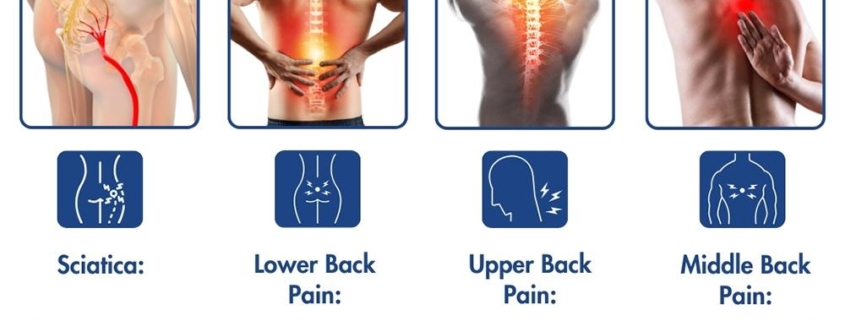7 Common Missteps in Managing Back Pain You Should Avoid
Back pain is a common ailment that affects millions of people worldwide, yet navigating its management can often feel like a daunting journey. With a plethora of advice available, it’s easy to fall into traps that can exacerbate discomfort instead of alleviating it. In this listicle, we’ll explore 7 common missteps in managing back pain that you should avoid. From misconceptions about rest to overlooking the importance of posture, each item will shed light on pitfalls that could hinder your recovery. By understanding these missteps, you’ll be better equipped to make informed choices, ultimately leading to a more effective approach to managing your back pain. So, let’s dive in and uncover the key mistakes that could be standing in the way of your comfort and well-being!
1) Ignoring the Pain: Many people make the mistake of toughing it out, believing that back pain will simply go away on its own. This can lead to worsening symptoms and prolonged discomfort, making it essential to acknowledge pain as a signal that something may need attention
Many individuals fall into the trap of believing that their back pain is merely a temporary inconvenience, one that will eventually fade away with time. This mindset can be detrimental, as it often leads to a cycle of neglect. When pain is brushed aside, it can escalate, transforming into chronic discomfort that hampers daily activities and reduces overall quality of life. Recognizing pain as a crucial indicator of underlying issues is vital. Ignoring it may not only prolong suffering but also complicate treatment options down the line.
Instead of toughing it out, consider taking proactive steps to address the discomfort. Here are some key actions to take when experiencing back pain:
- Consult a healthcare professional: A timely visit can help identify the root cause of the pain.
- Rest appropriately: While rest is important, prolonged inactivity can weaken muscles and worsen the problem.
- Engage in gentle movement: Activities like stretching or walking can promote healing and alleviate tension.
2) Over-Reliance on Painkillers: While medications can provide temporary relief, relying solely on painkillers can mask underlying issues. Its crucial to explore holistic approaches and not just treat the symptoms without addressing the root cause
Many individuals facing back pain often turn to painkillers as a quick fix, believing that these medications will alleviate their discomfort. However, this approach can lead to a cycle of dependency, where the painkillers merely mask the symptoms without addressing the underlying causes. Relying solely on these medications can prevent individuals from recognizing and treating the root issues, such as poor posture, muscle imbalances, or even stress-related tension. It’s essential to understand that while painkillers can provide temporary relief, they do not offer a long-term solution to back pain.
To promote a healthier approach to managing back pain, consider integrating holistic methods into your routine. This can include a variety of options such as:
- Physical Therapy: Tailored exercises can strengthen the muscles supporting your spine.
- Chiropractic Care: Regular adjustments may help realign the spine and alleviate discomfort.
- Mindfulness and Relaxation Techniques: Practices like yoga and meditation can reduce stress and tension.
- Nutrition: A balanced diet can support overall health and reduce inflammation.
By exploring these alternatives, you can create a comprehensive pain management plan that not only alleviates discomfort but also addresses the factors contributing to your back pain. This proactive approach empowers you to take control of your health, ensuring that you don’t just treat the symptoms but also work towards a more sustainable solution.
3) Neglecting Physical Activity: Some think that resting is the best way to heal from back pain, but inactivity can actually exacerbate the problem. Gentle movement and specific exercises can strengthen the back and alleviate pain over time
Many individuals believe that the best remedy for back pain is to take a break and rest. However, this approach can lead to a vicious cycle of inactivity, which may ultimately worsen the condition. When the body remains stationary for extended periods, muscles can weaken, joints can stiffen, and blood circulation can diminish, leading to increased discomfort. Instead of surrendering to inactivity, consider incorporating gentle movement into your daily routine. Activities such as walking, swimming, or yoga can help maintain flexibility and promote healing.
Engaging in specific exercises designed to strengthen the back can also play a crucial role in recovery. Focus on low-impact workouts that target the core and back muscles, as they provide support to the spine and improve overall stability. Here are some beneficial exercises to integrate into your regimen:
- Bridges: Strengthen the glutes and lower back.
- Cat-Cow Stretch: Enhance spinal flexibility.
- Bird-Dog: Improve balance and core stability.
Creating a balanced exercise plan can be as simple as dedicating a few minutes each day to these activities. Remember, the goal is to stay active, not to push through pain. Listen to your body, and gradually increase the intensity of your movements as you gain strength and confidence.
4) Poor Posture Habits: Many individuals underestimate the impact of posture on back health. Slouching or sitting improperly can strain the back muscles and spine, so its important to be mindful of posture throughout the day, especially while working or using devices
Many people often overlook how their daily posture can significantly affect their back health. Whether you’re sitting at a desk, lounging on the couch, or even scrolling through your phone, poor posture can lead to chronic pain and discomfort. Slouching and hunching over not only strain the back muscles but can also compress the spine, leading to long-term issues. To combat this, it’s essential to cultivate awareness of your body position throughout the day. Consider implementing the following strategies:
- Adjust your workspace: Ensure your chair and desk are ergonomically aligned to support your spine.
- Take regular breaks: Stand up, stretch, and move around every hour to relieve tension.
- Practice mindful sitting: Keep your feet flat on the ground and shoulders relaxed while sitting.
- Incorporate exercises: Strengthening your core can promote better posture and alleviate strain on your back.
Furthermore, the way you use devices can exacerbate poor posture habits. Many individuals find themselves leaning forward or craning their necks while using smartphones or tablets, which can lead to a condition often referred to as “tech neck.” To mitigate these effects, consider the following adjustments:
| Tips for Better Device Posture | Benefits |
|---|---|
| Hold devices at eye level | Reduces neck strain |
| Use a stand or holder | Encourages proper alignment |
| Limit screen time | Prevents repetitive strain |
| Engage in regular stretching | Improves flexibility and reduces tension |
5) Skipping Professional Help: Some people hesitate to seek professional guidance, believing they can manage their back pain independently. Consulting a healthcare provider or physical therapist can provide valuable insights and tailored treatment plans that can lead to effective relief
Many individuals believe they can tough it out and manage their back pain without professional assistance. However, this mindset can lead to prolonged discomfort and potentially exacerbate underlying issues. Consulting a healthcare provider or physical therapist is crucial, as they can offer an accurate diagnosis and help identify the root causes of your pain. By doing so, you gain access to tailored treatment plans that may include specific exercises, manual therapy, or even lifestyle adjustments designed to alleviate your discomfort effectively.
Moreover, working with a professional can reveal insights that self-management often overlooks. For instance, they can educate you on proper body mechanics, posture corrections, and ergonomic adjustments that may significantly reduce strain on your back. Here are some key benefits of seeking professional help:
- Personalized Assessment: Understanding your unique condition.
- Targeted Treatment: Customized exercises and therapies.
- Preventive Strategies: Learning how to avoid future injuries.
- Accountability: Regular check-ins to monitor progress.
6) Inconsistent Treatment Routines: Starting a treatment plan but failing to stick with it can hinder progress. Consistency is key in managing back pain, whether its through physical therapy, exercises, or lifestyle changes, to see long-term benefits
Many individuals embark on a treatment journey for their back pain, but inconsistency often derails their progress. Whether it’s skipping physical therapy sessions, neglecting prescribed exercises, or failing to incorporate recommended lifestyle changes, these lapses can significantly hinder recovery. To truly benefit from a treatment plan, it’s essential to establish a routine that you can realistically maintain. This means setting aside dedicated time for exercises, adhering to dietary suggestions, and making the necessary adjustments to your daily habits.
To help you stay on track, consider creating a structured plan that includes:
- Daily Exercise Schedule: Set specific times for stretching and strengthening exercises.
- Weekly Therapy Appointments: Commit to regular visits with your therapist to monitor progress.
- Health Journal: Keep track of your pain levels and activities to identify patterns and triggers.
By committing to these routines, you can create a supportive environment for your recovery. Remember, consistency is not just about frequency; it’s about making back pain management a priority in your life.
7) Ignoring Lifestyle Factors: Diet, sleep, and stress can all contribute to back pain, yet many overlook these aspects. Addressing lifestyle factors holistically can significantly improve overall well-being and reduce the frequency and intensity of back pain episodes
When it comes to managing back pain, many people focus solely on physical treatments, neglecting essential lifestyle factors that play a crucial role in overall health. Diet is one such factor; a balanced diet rich in anti-inflammatory foods can help reduce pain and promote healing. Incorporating foods like leafy greens, fatty fish, nuts, and berries can provide the nutrients your body needs to combat inflammation. Additionally, staying hydrated is vital, as dehydration can lead to muscle cramps and increased discomfort. Furthermore, stress management is equally important, as chronic stress can lead to muscle tension and exacerbate pain. Techniques such as mindfulness, yoga, or even simple breathing exercises can significantly reduce stress levels and improve your body’s response to pain.
Another critical element often overlooked is sleep. Quality sleep is essential for recovery, yet many struggle with sleep disturbances that can worsen back pain. Establishing a consistent sleep schedule, creating a restful environment, and practicing good sleep hygiene can enhance sleep quality. Consider incorporating a relaxing bedtime routine, such as reading or gentle stretching, to signal to your body that it’s time to wind down. The table below highlights how these lifestyle factors interconnect to support back health:
| Factor | Impact on Back Pain | Tips for Improvement |
|---|---|---|
| Diet | Reduces inflammation | Incorporate anti-inflammatory foods |
| Sleep | Enhances recovery | Establish a sleep routine |
| Stress | Reduces muscle tension | Practice mindfulness techniques |
The Way Forward
As we wrap up our exploration of the seven common missteps in managing back pain, it’s clear that navigating this intricate landscape requires a blend of knowledge, patience, and a touch of self-compassion. Each misstep serves as a reminder that the journey to relief is not a one-size-fits-all approach. By recognizing and avoiding these pitfalls, you empower yourself to take control of your back health and make informed decisions that align with your body’s unique needs.
Remember, back pain is often a complex puzzle, and finding the right pieces can take time. Whether you’re seeking advice from healthcare professionals, exploring new therapies, or simply learning to listen to your body, every step you take brings you closer to a more comfortable existence. So, take a deep breath, be gentle with yourself, and embrace the path toward healing. Here’s to making informed choices and moving forward with confidence—your back will thank you!










Leave a Reply
Want to join the discussion?Feel free to contribute!